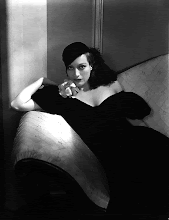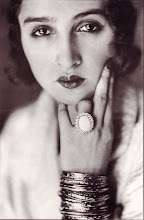
Norma Shearer by Hurrell
I found an interesting glimpse into studio life from a photographer's point of view in the introduction to Hollywood Glamor Portraits

“…a major studio like Paramount had only two men in charge – Eugene Robert Richee in the No. 1 Gallery and William Walling in No. 2. (It was the same at the other studios.) The bulk of the Paramount portraits came from these two, who did almost everything for the sittings except hang the drapes. Walling estimated that he averaged about 65 portraits a day, six days a week, for the first three years. Sittings would be arranged for any time the stars had free between films; or after a day on the set they would appear at 6.00 at the gallery for portrait sessions that would continue until there were enough good shots.

Marlene by William Walling
“The value of the stills photographers to their employers lay in their ability to make people want to see the star, by creating a photograph equivalent of the accumulative impact of the whole movie. It was the Harlow of Hurrell’s photographs you sought in the films, and her close-up, when it came in the plot took a lot of its lighting ideas from the Hurrell original. It was, as a matter of fact, quite common for a stills photographer of Hurrell’s stature to be brought out to the set to assist in lighting the close-ups.

Harlow by Hurrell
"There were few directors as knowledgeable or as consummately skilled in achieving the same results as the gallery photographer. Josef von Sternberg was, of course, the outstanding exception. No one ever understood the Dietrich face as he did, and the best portraits of her were those taken on the set by the publicity photographer on stand-by, employing Sternberg’s lighting set-up and pose. But the exception proved the rule; most directors and cameramen would have been delighted to achieve on film the look of a Hurrell, Bull or Bachrach. Special film images, like the one in The Spiral Staircase when one sees on the screen a close-up of the eye of the murderer in whose pupil is reflected the victim-to-be, were also done in the gallery, this particular one by Ernest Bachrach.

“Among the problems of the gallery photographers were how to deal with the stars whose image they were selling – how to liven up weary, bored or unwilling actors. Not all of them enjoyed being photographed as Crawford did. Hurrell said “She believed in the star thing, and everything that went with it. She could make artificial poses seem so real, going on and on loving it. She’d set aside a whole day, changing into maybe twenty different gowns, hairdos, make-up, everything. I probably shot more stills of her than anyone else. Let her stand stiff and aristocratic and she’d be off.”

Joan Crawford by Laszlo Willinger
"Others, like Gary Cooper and Bing Crosby, were lethargic; John Barrymore and W. C. Fields positively loathed the process. The photographers had to deal with all of them.

Gary Cooper by Clarence Sinclair Bull
"Not only great stars, already formed, came to the galleries, but also aspiring actors and actresses who did not as yet have a public image which the studios could sell. Stills would serve as a cheap screen test, capturing them in every way, every mood, costume, setting until the face clicked. The studio heads would then decide on the basis of these photographs whether a screen test was worthwhile.

Lana Turner by Madison Lacy
"The gallery photographers answered to the publicity and advertising departments. Publicity wanted a basic head shot against a flat background that would reproduce well in the cheapest pulp magazines and in newspapers. Art studies were done for fan magazines…”

Clara Bow by E. R. Richee












2 comments:
I want this book!!!! :(
Me too! I've put it on my amazon wish list!
Post a Comment